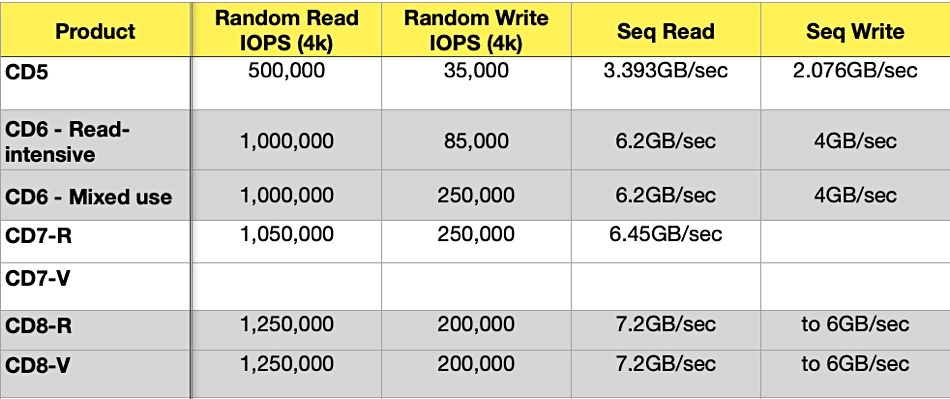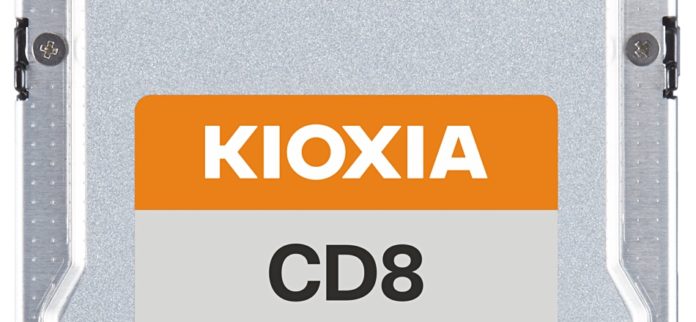Kioxia has announced a faster datacenter SSD using PCIe 5 and revealed plans for a new fab so it can up drive production capacity.
It is sampling the CD8 – an updated and faster version of the CD6 using denser 112-layer NAND and replacing the PCIe 4 interconnect. PCIe 5 operates at 4GB/sec per lane, double PCIe 4’s 2GB/sec per lane, which, again, is double PCIe 3’s 1GB/sec per lane.

Greg Wong, founder and principal analyst at Forward Insights, commented in a statement for Kioxia: “Next-generation PCIe 5.0 SSDs provide twice the level of performance, and will continue to propel the PCIe/NVMe SSD market – which is expected to grow at a CAGR of over 20 per cent out to 2026.”
The CD series single-port datacenter drives use Kioxia flash firmware and controllers. The CD6 was announced in February 2020 and its PCIe 4 interface provided a big jump in speed for the prior PCIe 3 CD5 product. The drives come in read-intensive and mixed-use versions, with similar performance but different capacities and endurance. The read-intensive capacity points are 960GB and 1.92, 3.84, 7.68, and 15.56TB with a 1 drive write per day (DWPD) endurance rating. The mixed-used drives have a 3 DWPD rating and lower capacities due to over-provisioning; 800GB and 1.6, 3.2, 6.4, and 12.8TB.
A potted history of the CD series looks like this:
- CD5: PCIe 3 – 64-layer TLC, 2.5-inch format
- CD6: PCIe 4 – 96-layer TLC, 2.5-inch
- CD7: PCIe 5 – 96-layer TLC, ES3 ruler
- CD8: PCIe 5 – 112-layer TLC, 2.5-inch
The CD8 is a successor to the CD6, not the CD7, as the CD7 is a CD6-type (96-layer) drive in the ES3 ruler format. A table shows how the maximum IOPS and bandwidth have risen with each generation:

The CD8 has 25 per cent more maximum random read IOPS than the CD6, more than twice as many maximum random write IOPS in the read-intensive variant but 20 per cent less in the mixed-use model. That suggests Kioxia has found it harder to get the 112-layer NAND to do random writes than working with the 96-layer flash. The sequential performance improvement is more consistent. Overall Kioxia says there is an up to 135 per cent performance increase over the CD6.
The CD8 is also generally faster than the CD7, apart from random write IOPS. Both use the PCIe 5 interface and the CD8’s controller does a better job in terms of speed than the CD7.
The CD8 is optimized for hyperscale datacenter and enterprise server-attached workloads such as high-performance computing, artificial intelligence, caching layer, content streaming, and financial trading and analysis. The drive supports the Open Compute Project (OCP) Datacenter NVMe SSD 2.0 standard.
The CD8 series is now available for customer evaluation.
Samsung also has an enterprise PCIe 5 SSD – the PM1743 – and this is a much faster dual-port device, with up to 2.5 million random read IOPS and 13GB/sec sequential read speed.
Fab expansion
The NAND market faces steady growth as demand for chips and SSDs increases in enterprises, hyperscaler customers, and the automotive market. In light of that, Kioxia is increasing its 3D NAND fab capacity at its Kitakami Plant in Iwate Prefecture, Japan. Construction of a second fab there will start next month and complete some time in 2023. Kioxia will fund the Fab 2 capital investment from its operating cash flow.
Fab 2 will have an earthquake-resistant design and use energy-saving manufacturing equipment and renewable energy sources, Kioxia said.
Kioxia said it will use AI-based manufacturing to increase the production capacity of the entire Kitakami Plant, and it also plans to hold discussions with Western Digital about expanding their flash joint venture to include this Fab 2 investment.








